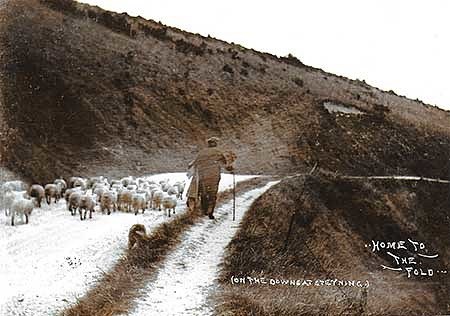
Counting Sheep.
It is unwise – as we shall see - to try to count sheep after drinking home-made wine. But counting sheep – or, indeed any other animals – is and always was important to the owners of the flocks.In the days when some eighteen to twenty thousand sheep were sold at the Findon Sheep Fair each September the shepherds would drive their sheep from their grazing grounds on the Downs with the help of their dogs. There the sheep from each flock would be counted and marked with individual paint sticks known as ‘tivers’. Some of the shepherds like ‘Old Shep’ who lived in Church Lane, having penned their sheep, would have a drink or two (and more) and would then go back up to the Downs to sleep it off with their flock. In the 1920’s the cheapest way of getting the sheep to buyers who lived any distance away was by train – and the closest rail head to Findon was at Steyning. So Taffy, the most expert of the drovers, would assemble as many as four thousand sheep at one time and, with one dog leading, another driving and one on either side would move this vast flock over the Downs to the Market Field at Steyning where they would spend the night before being loaded into cattle trucks at the station the next day.
When William de Saon reckoned up the marks on his tally sticks at Michaelmas in 1338 he found that the Manor of Steyning owned 488 sheep – rams, ewes, hoggets (2 year old sheep) and lambs. Then, as the centuries passed, the reckoning became the responsibility of appraisers who were required to make an inventory of all the goods, chattels and stock of all the wealthier individuals in the community, when they died. So, William Skynner and Thomas Longmer counted '177 sheepe' (valued at £72), among many other things, on the farm of Robert Gravett of Steyning on his death in 1641. He must have been a substantial farmer but many others, often described as husbandmen, had quite small holdings. In 1612 Robert Easted, for instance, had only '5 ewes with lambes' and 'one ram' (valued together at £2 6s 8d).
By the early 20th century stock-taking was done annually on larger farms, as it had anciently been done on the demesne of the Manor of Steyning. John Cox (the vicar’s son), who was a young trainee at H. J. Burt, recalled a visit to one Downland farm where he and the farmer’s son, Bernie, spent the morning valuing cattle, hay, straw and roots. They then sat down to a substantial meal of roast mutton and home-brewed ale at the end of which 'Mrs. Harris proudly produced a bottle of her home-made elderberry wine and poured out a liberal amount for each of us. At that stage in my life I was almost completely ignorant of the potency of home-made wines and I was loud in my praises, so much so that I was poured another glass. Having thanked my hosts for the wonderful repast Bernie and I took the narrow lane up to the Downs and their flock of Southdown sheep. Bernie said that there were about 800 but he had mislaid his record book and it became necessary to count the inmates of the various fields and to value them accordingly. Let it be said that to count sheep in a field is normally far from easy but, with alcohol flowing through our veins, it became practically impossible. We tried several times and each time there was a lack of clarity, producing only wooly blurs which appeared to be constantly on the move. On the way back to the farmhouse I tripped over a rabbit hole.' So, when Bernie was asked how we had got on his reply was 'Alright Ma. Young John can’t count sheep, but he can blaspheme well.'
Perhaps William de Saon’s tally sticks were more reliable than John Cox’s attempts at a drink befuddled visual count.
Steyning Museum Opening Times:
Tuesday, Wed & Friday: 10.30 - 12.30; 14.30 - 16.00
Saturday: 10.30 - 16.00 - Sunday: 14.30 - 16.00
E: contact@steyningmuseum.org.uk
W: www.steyningmuseum.org.uk T: 01903 813333

